Comprehensive Analysis: Supply Chain, Logistics, and Lean Management
VerifiedAdded on 2022/08/22
|14
|3052
|24
Report
AI Summary
This report provides a comprehensive analysis of supply chain management, focusing on the palm oil industry and the KFC restaurant chain. It explores the theoretical models of supply chain, detailing the flow of materials, finances, and information. The report highlights key issues within the palm oil supply chain, such as deforestation, health concerns, cost, and lack of transparency, while also proposing potential areas for development including sustainable plantation practices and investment in green initiatives. The analysis extends to environmental-friendly logistics, emphasizing green purchasing, production, transportation, and packaging. The report also discusses the benefits and challenges of outsourcing logistics, as well as addressing operational issues at KFC through lean management principles, focusing on waste elimination, staff training, and improved customer service. The report is a valuable resource for students studying supply chain management, logistics, and business development, offering insights into practical applications and strategic improvements.
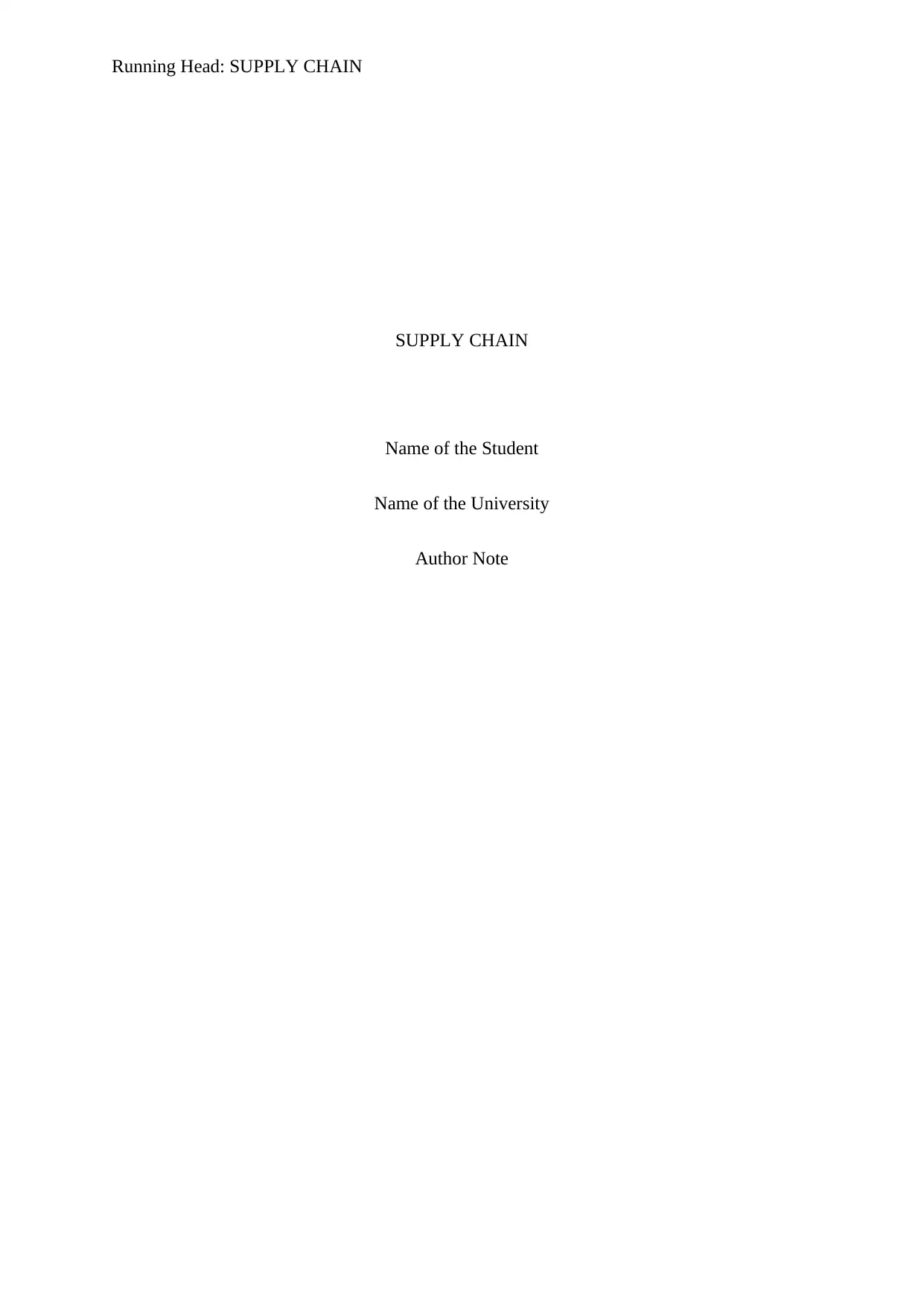
Running Head: SUPPLY CHAIN
SUPPLY CHAIN
Name of the Student
Name of the University
Author Note
SUPPLY CHAIN
Name of the Student
Name of the University
Author Note
Paraphrase This Document
Need a fresh take? Get an instant paraphrase of this document with our AI Paraphraser

1
SUPPLY CHAIN
Table of Contents
Supply Chain Management........................................................................................................2
Logistics.....................................................................................................................................5
Lean Management......................................................................................................................9
References................................................................................................................................12
SUPPLY CHAIN
Table of Contents
Supply Chain Management........................................................................................................2
Logistics.....................................................................................................................................5
Lean Management......................................................................................................................9
References................................................................................................................................12
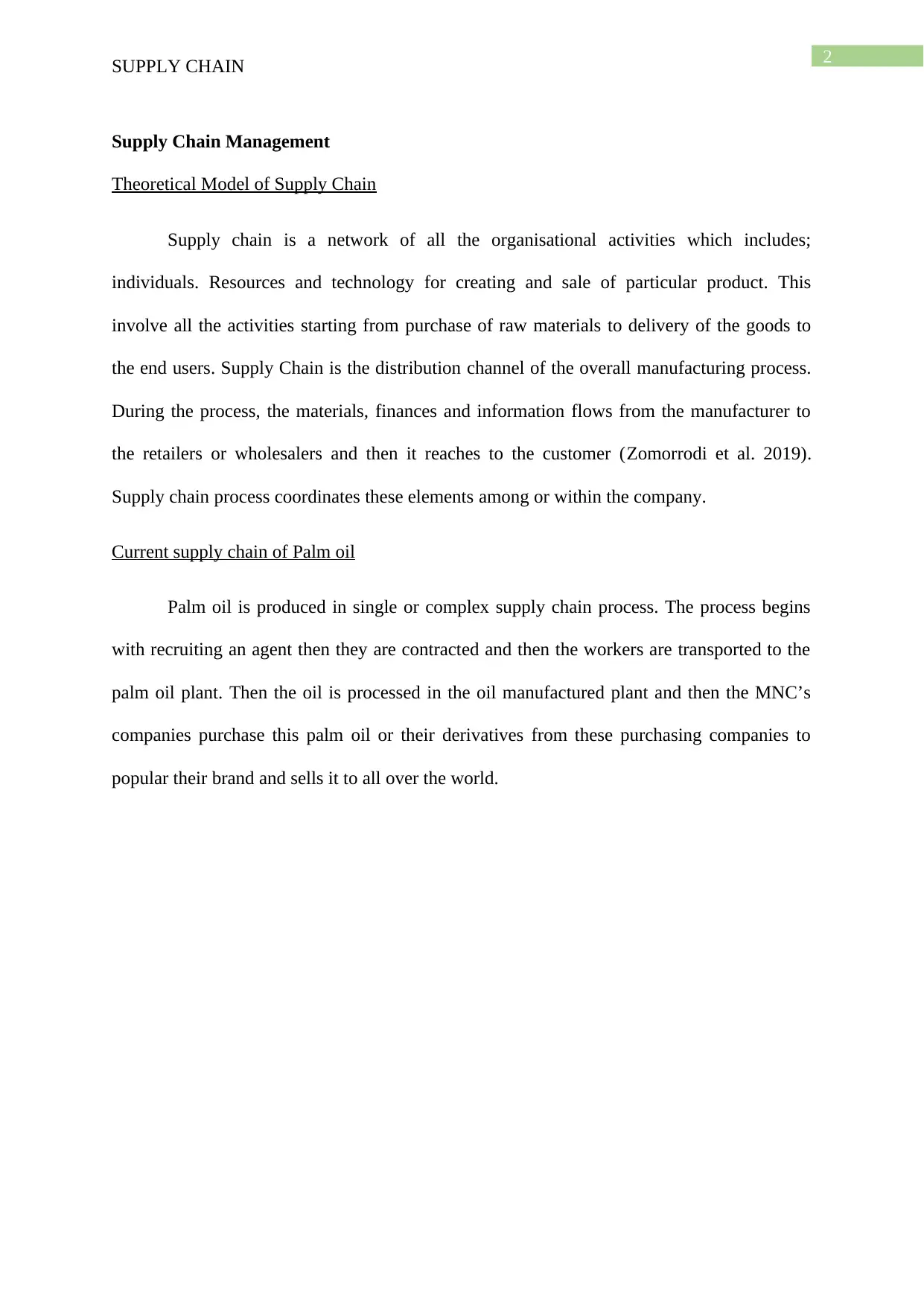
2
SUPPLY CHAIN
Supply Chain Management
Theoretical Model of Supply Chain
Supply chain is a network of all the organisational activities which includes;
individuals. Resources and technology for creating and sale of particular product. This
involve all the activities starting from purchase of raw materials to delivery of the goods to
the end users. Supply Chain is the distribution channel of the overall manufacturing process.
During the process, the materials, finances and information flows from the manufacturer to
the retailers or wholesalers and then it reaches to the customer (Zomorrodi et al. 2019).
Supply chain process coordinates these elements among or within the company.
Current supply chain of Palm oil
Palm oil is produced in single or complex supply chain process. The process begins
with recruiting an agent then they are contracted and then the workers are transported to the
palm oil plant. Then the oil is processed in the oil manufactured plant and then the MNC’s
companies purchase this palm oil or their derivatives from these purchasing companies to
popular their brand and sells it to all over the world.
SUPPLY CHAIN
Supply Chain Management
Theoretical Model of Supply Chain
Supply chain is a network of all the organisational activities which includes;
individuals. Resources and technology for creating and sale of particular product. This
involve all the activities starting from purchase of raw materials to delivery of the goods to
the end users. Supply Chain is the distribution channel of the overall manufacturing process.
During the process, the materials, finances and information flows from the manufacturer to
the retailers or wholesalers and then it reaches to the customer (Zomorrodi et al. 2019).
Supply chain process coordinates these elements among or within the company.
Current supply chain of Palm oil
Palm oil is produced in single or complex supply chain process. The process begins
with recruiting an agent then they are contracted and then the workers are transported to the
palm oil plant. Then the oil is processed in the oil manufactured plant and then the MNC’s
companies purchase this palm oil or their derivatives from these purchasing companies to
popular their brand and sells it to all over the world.
⊘ This is a preview!⊘
Do you want full access?
Subscribe today to unlock all pages.

Trusted by 1+ million students worldwide
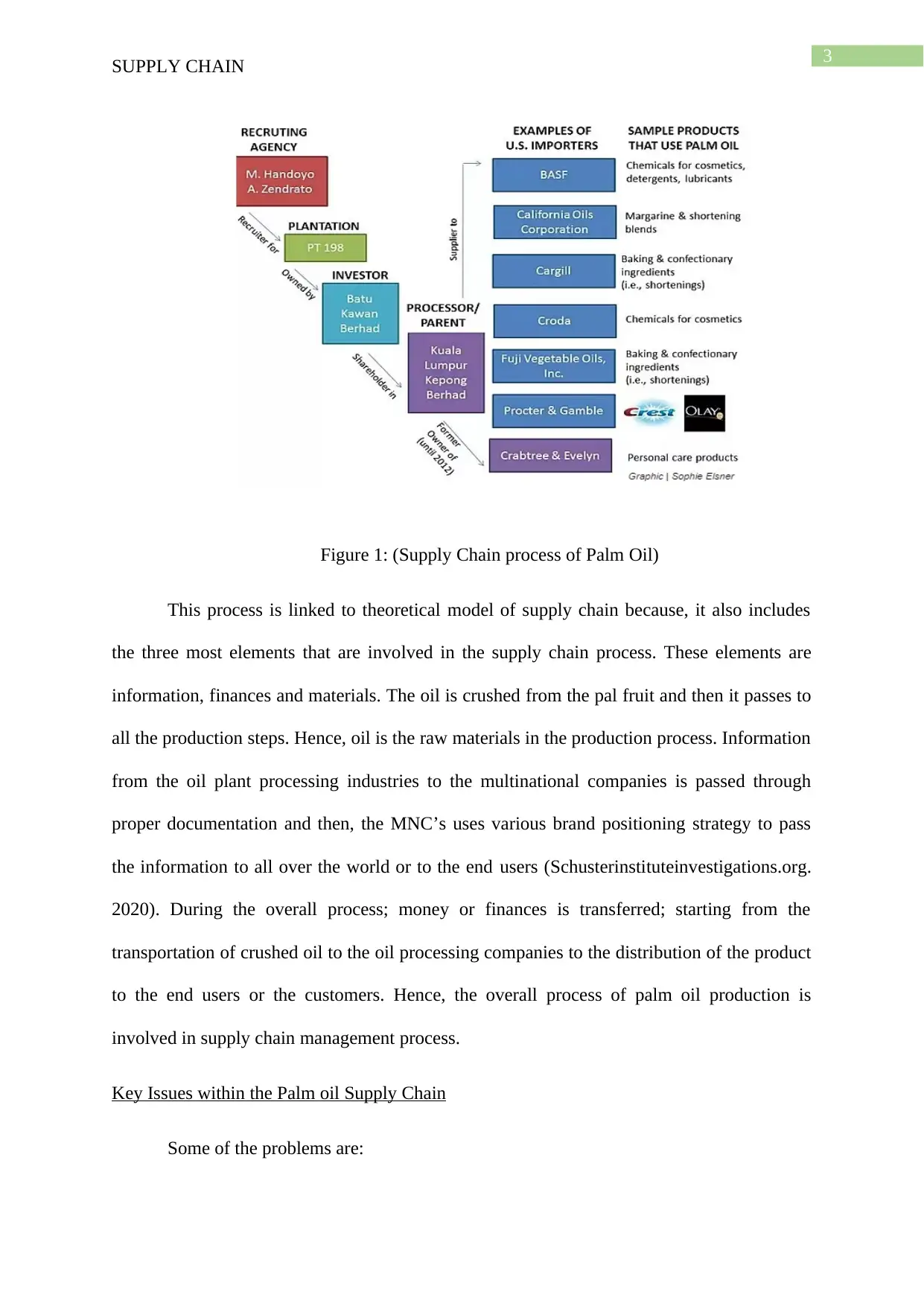
3
SUPPLY CHAIN
Figure 1: (Supply Chain process of Palm Oil)
This process is linked to theoretical model of supply chain because, it also includes
the three most elements that are involved in the supply chain process. These elements are
information, finances and materials. The oil is crushed from the pal fruit and then it passes to
all the production steps. Hence, oil is the raw materials in the production process. Information
from the oil plant processing industries to the multinational companies is passed through
proper documentation and then, the MNC’s uses various brand positioning strategy to pass
the information to all over the world or to the end users (Schusterinstituteinvestigations.org.
2020). During the overall process; money or finances is transferred; starting from the
transportation of crushed oil to the oil processing companies to the distribution of the product
to the end users or the customers. Hence, the overall process of palm oil production is
involved in supply chain management process.
Key Issues within the Palm oil Supply Chain
Some of the problems are:
SUPPLY CHAIN
Figure 1: (Supply Chain process of Palm Oil)
This process is linked to theoretical model of supply chain because, it also includes
the three most elements that are involved in the supply chain process. These elements are
information, finances and materials. The oil is crushed from the pal fruit and then it passes to
all the production steps. Hence, oil is the raw materials in the production process. Information
from the oil plant processing industries to the multinational companies is passed through
proper documentation and then, the MNC’s uses various brand positioning strategy to pass
the information to all over the world or to the end users (Schusterinstituteinvestigations.org.
2020). During the overall process; money or finances is transferred; starting from the
transportation of crushed oil to the oil processing companies to the distribution of the product
to the end users or the customers. Hence, the overall process of palm oil production is
involved in supply chain management process.
Key Issues within the Palm oil Supply Chain
Some of the problems are:
Paraphrase This Document
Need a fresh take? Get an instant paraphrase of this document with our AI Paraphraser
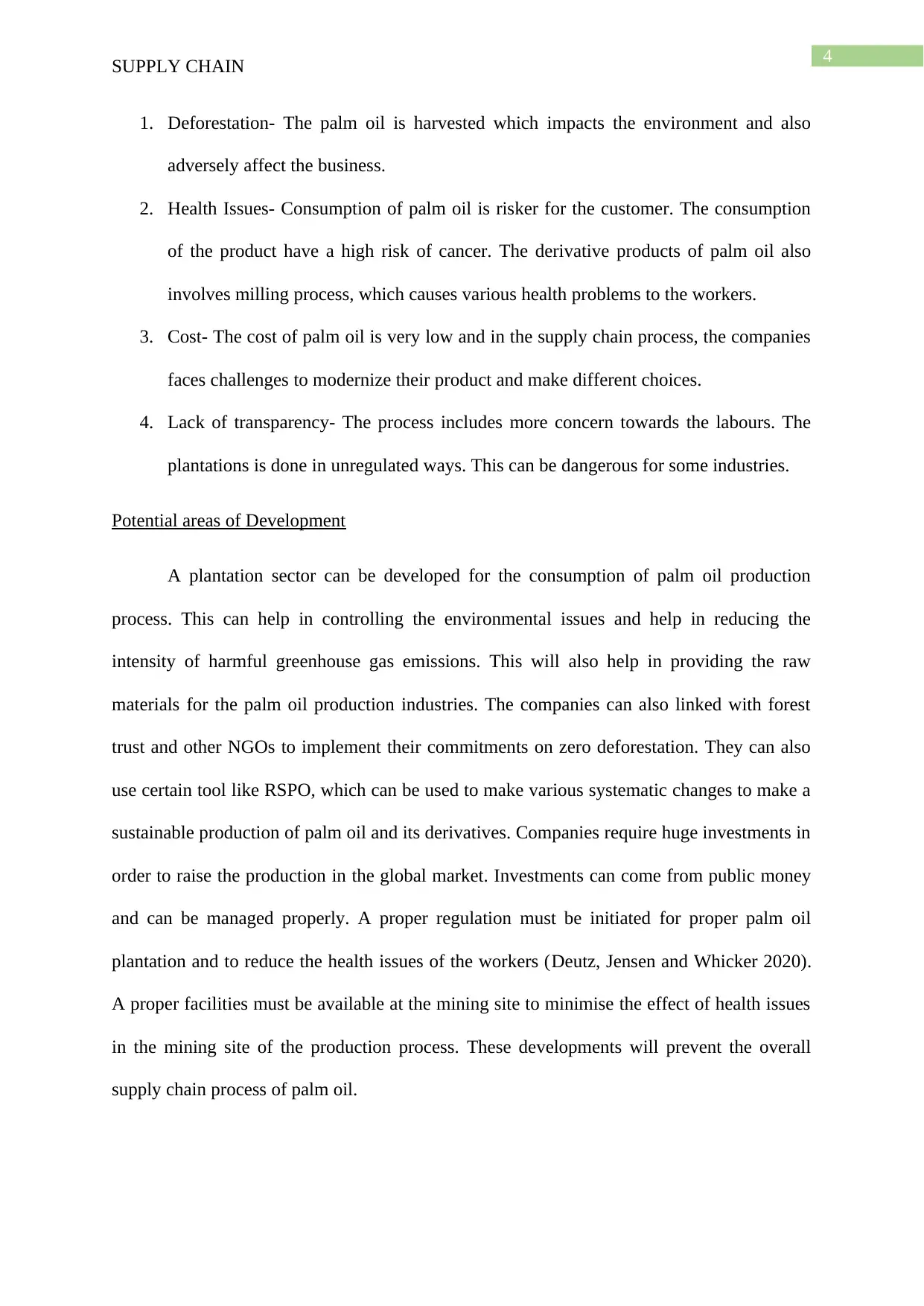
4
SUPPLY CHAIN
1. Deforestation- The palm oil is harvested which impacts the environment and also
adversely affect the business.
2. Health Issues- Consumption of palm oil is risker for the customer. The consumption
of the product have a high risk of cancer. The derivative products of palm oil also
involves milling process, which causes various health problems to the workers.
3. Cost- The cost of palm oil is very low and in the supply chain process, the companies
faces challenges to modernize their product and make different choices.
4. Lack of transparency- The process includes more concern towards the labours. The
plantations is done in unregulated ways. This can be dangerous for some industries.
Potential areas of Development
A plantation sector can be developed for the consumption of palm oil production
process. This can help in controlling the environmental issues and help in reducing the
intensity of harmful greenhouse gas emissions. This will also help in providing the raw
materials for the palm oil production industries. The companies can also linked with forest
trust and other NGOs to implement their commitments on zero deforestation. They can also
use certain tool like RSPO, which can be used to make various systematic changes to make a
sustainable production of palm oil and its derivatives. Companies require huge investments in
order to raise the production in the global market. Investments can come from public money
and can be managed properly. A proper regulation must be initiated for proper palm oil
plantation and to reduce the health issues of the workers (Deutz, Jensen and Whicker 2020).
A proper facilities must be available at the mining site to minimise the effect of health issues
in the mining site of the production process. These developments will prevent the overall
supply chain process of palm oil.
SUPPLY CHAIN
1. Deforestation- The palm oil is harvested which impacts the environment and also
adversely affect the business.
2. Health Issues- Consumption of palm oil is risker for the customer. The consumption
of the product have a high risk of cancer. The derivative products of palm oil also
involves milling process, which causes various health problems to the workers.
3. Cost- The cost of palm oil is very low and in the supply chain process, the companies
faces challenges to modernize their product and make different choices.
4. Lack of transparency- The process includes more concern towards the labours. The
plantations is done in unregulated ways. This can be dangerous for some industries.
Potential areas of Development
A plantation sector can be developed for the consumption of palm oil production
process. This can help in controlling the environmental issues and help in reducing the
intensity of harmful greenhouse gas emissions. This will also help in providing the raw
materials for the palm oil production industries. The companies can also linked with forest
trust and other NGOs to implement their commitments on zero deforestation. They can also
use certain tool like RSPO, which can be used to make various systematic changes to make a
sustainable production of palm oil and its derivatives. Companies require huge investments in
order to raise the production in the global market. Investments can come from public money
and can be managed properly. A proper regulation must be initiated for proper palm oil
plantation and to reduce the health issues of the workers (Deutz, Jensen and Whicker 2020).
A proper facilities must be available at the mining site to minimise the effect of health issues
in the mining site of the production process. These developments will prevent the overall
supply chain process of palm oil.
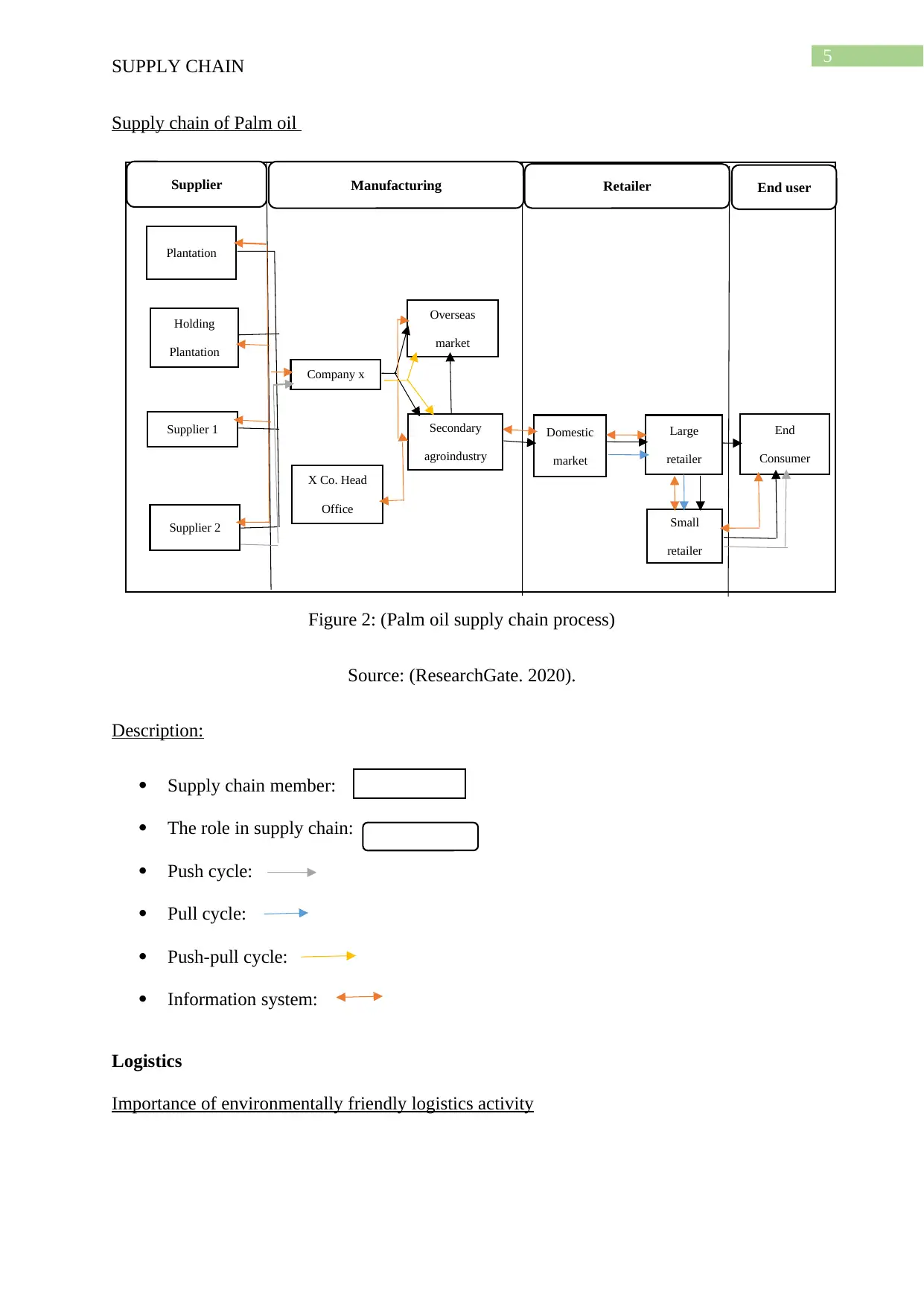
5
SUPPLY CHAIN
Supply chain of Palm oil
Figure 2: Palm oil supply chain process
Figure 2: (Palm oil supply chain process)
Source: (ResearchGate. 2020).
Description:
Supply chain member:
The role in supply chain:
Push cycle:
Pull cycle:
Push-pull cycle:
Information system:
Logistics
Importance of environmentally friendly logistics activity
Supplier Manufacturing Retailer End user
Plantation
Holding
Plantation
Supplier 1
Supplier 2
Overseas
market
Company x
Secondary
agroindustry
X Co. Head
Office
Domestic
market
Large
retailer
Small
retailer
End
Consumer
SUPPLY CHAIN
Supply chain of Palm oil
Figure 2: Palm oil supply chain process
Figure 2: (Palm oil supply chain process)
Source: (ResearchGate. 2020).
Description:
Supply chain member:
The role in supply chain:
Push cycle:
Pull cycle:
Push-pull cycle:
Information system:
Logistics
Importance of environmentally friendly logistics activity
Supplier Manufacturing Retailer End user
Plantation
Holding
Plantation
Supplier 1
Supplier 2
Overseas
market
Company x
Secondary
agroindustry
X Co. Head
Office
Domestic
market
Large
retailer
Small
retailer
End
Consumer
⊘ This is a preview!⊘
Do you want full access?
Subscribe today to unlock all pages.

Trusted by 1+ million students worldwide
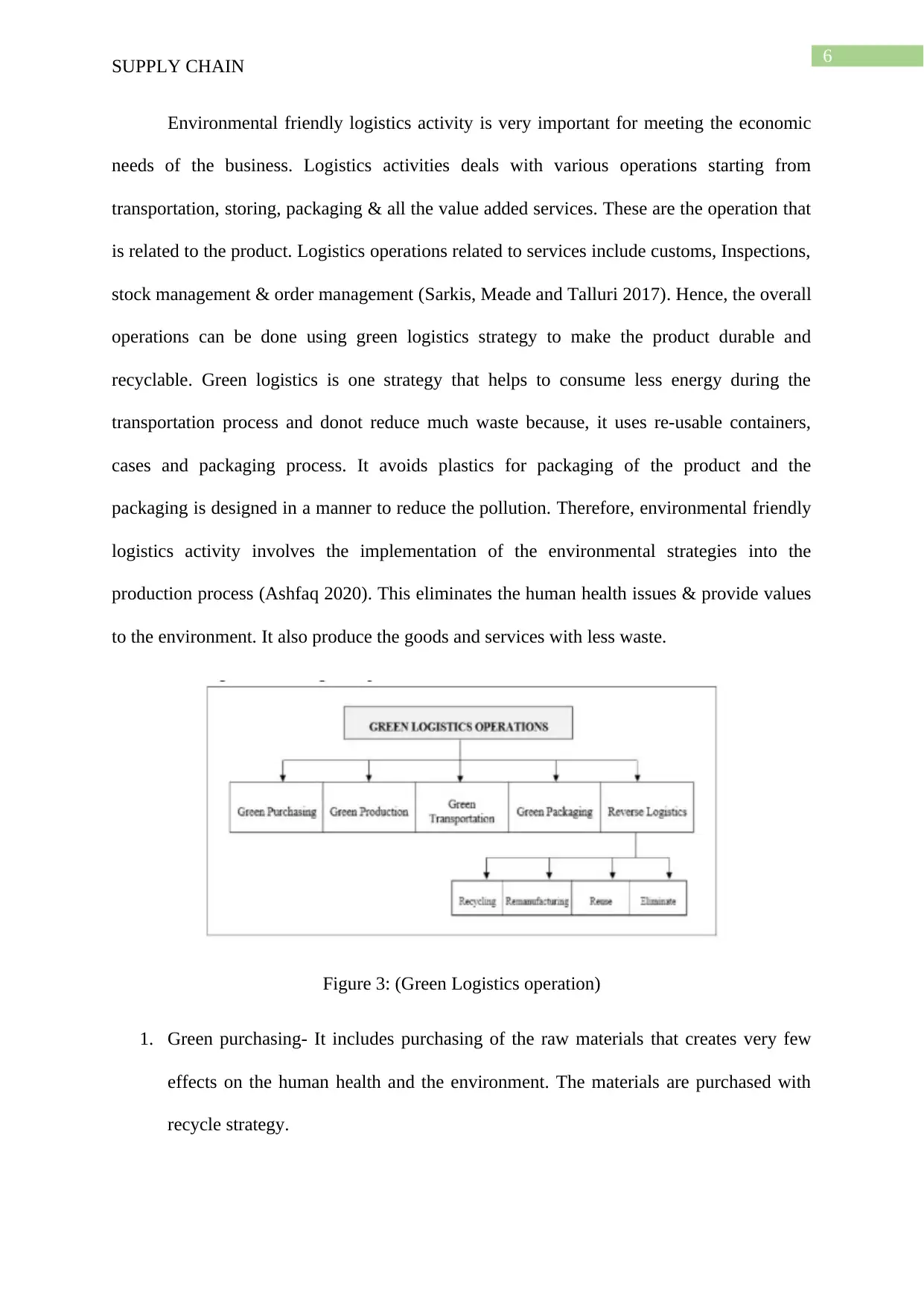
6
SUPPLY CHAIN
Environmental friendly logistics activity is very important for meeting the economic
needs of the business. Logistics activities deals with various operations starting from
transportation, storing, packaging & all the value added services. These are the operation that
is related to the product. Logistics operations related to services include customs, Inspections,
stock management & order management (Sarkis, Meade and Talluri 2017). Hence, the overall
operations can be done using green logistics strategy to make the product durable and
recyclable. Green logistics is one strategy that helps to consume less energy during the
transportation process and donot reduce much waste because, it uses re-usable containers,
cases and packaging process. It avoids plastics for packaging of the product and the
packaging is designed in a manner to reduce the pollution. Therefore, environmental friendly
logistics activity involves the implementation of the environmental strategies into the
production process (Ashfaq 2020). This eliminates the human health issues & provide values
to the environment. It also produce the goods and services with less waste.
Figure 3: (Green Logistics operation)
1. Green purchasing- It includes purchasing of the raw materials that creates very few
effects on the human health and the environment. The materials are purchased with
recycle strategy.
SUPPLY CHAIN
Environmental friendly logistics activity is very important for meeting the economic
needs of the business. Logistics activities deals with various operations starting from
transportation, storing, packaging & all the value added services. These are the operation that
is related to the product. Logistics operations related to services include customs, Inspections,
stock management & order management (Sarkis, Meade and Talluri 2017). Hence, the overall
operations can be done using green logistics strategy to make the product durable and
recyclable. Green logistics is one strategy that helps to consume less energy during the
transportation process and donot reduce much waste because, it uses re-usable containers,
cases and packaging process. It avoids plastics for packaging of the product and the
packaging is designed in a manner to reduce the pollution. Therefore, environmental friendly
logistics activity involves the implementation of the environmental strategies into the
production process (Ashfaq 2020). This eliminates the human health issues & provide values
to the environment. It also produce the goods and services with less waste.
Figure 3: (Green Logistics operation)
1. Green purchasing- It includes purchasing of the raw materials that creates very few
effects on the human health and the environment. The materials are purchased with
recycle strategy.
Paraphrase This Document
Need a fresh take? Get an instant paraphrase of this document with our AI Paraphraser

7
SUPPLY CHAIN
2. Green production- This involves the production of the goods and services with little
elimination of the wastes and adding values to the environment. The production lines
are designed in such a way that it saves a lot of energy.
3. Green transportation- The distribution process has focused on controlling the
environmental pollution in the distribution activities (Nilsson, Sternberg and Klaas-
Wissing 2017). The factors affecting the distribution process like fuels from
transportation vehicles are shaped in this strategy. The packaging system is done in
such a way that it can be recyclable and can be used in the supply chain process.
4. Green packaging- In this process, ecological packaging is added to add value to the
human & animal wealth. Packages are manufactured in a way that it reduces the usage
of harmful materials that can harm the environment.
5. Reverse logistics- This operations includes; recycling of all the unwanted materials
like bottles, papers, boxes and other raw materials with a purpose of using it again in
the production process. The process involves; production, recycling of the resources,
elimination of wastes and re-manufacturing of the activities.
Outsource logistics on environmental credentials of a business
Outsource logistics involves the use of various outside parties in a business to
manage their supply chain activities. These parties are known as 3rd party logistics. They
exercise the organisational strategies by providing them best logistics practices in their
supply chain process. These parties provides logistics expertise and consultancy supports
to optimise the supply chain process. They are very much helpful in managing the
transparency of the supply chain process. The experts manage the material flow by
providing cost savings advices. They manage the resources, technologies and capabilities
of the organisation (Brzezinski 2016). The outsource logistics provides expertise in
SUPPLY CHAIN
2. Green production- This involves the production of the goods and services with little
elimination of the wastes and adding values to the environment. The production lines
are designed in such a way that it saves a lot of energy.
3. Green transportation- The distribution process has focused on controlling the
environmental pollution in the distribution activities (Nilsson, Sternberg and Klaas-
Wissing 2017). The factors affecting the distribution process like fuels from
transportation vehicles are shaped in this strategy. The packaging system is done in
such a way that it can be recyclable and can be used in the supply chain process.
4. Green packaging- In this process, ecological packaging is added to add value to the
human & animal wealth. Packages are manufactured in a way that it reduces the usage
of harmful materials that can harm the environment.
5. Reverse logistics- This operations includes; recycling of all the unwanted materials
like bottles, papers, boxes and other raw materials with a purpose of using it again in
the production process. The process involves; production, recycling of the resources,
elimination of wastes and re-manufacturing of the activities.
Outsource logistics on environmental credentials of a business
Outsource logistics involves the use of various outside parties in a business to
manage their supply chain activities. These parties are known as 3rd party logistics. They
exercise the organisational strategies by providing them best logistics practices in their
supply chain process. These parties provides logistics expertise and consultancy supports
to optimise the supply chain process. They are very much helpful in managing the
transparency of the supply chain process. The experts manage the material flow by
providing cost savings advices. They manage the resources, technologies and capabilities
of the organisation (Brzezinski 2016). The outsource logistics provides expertise in
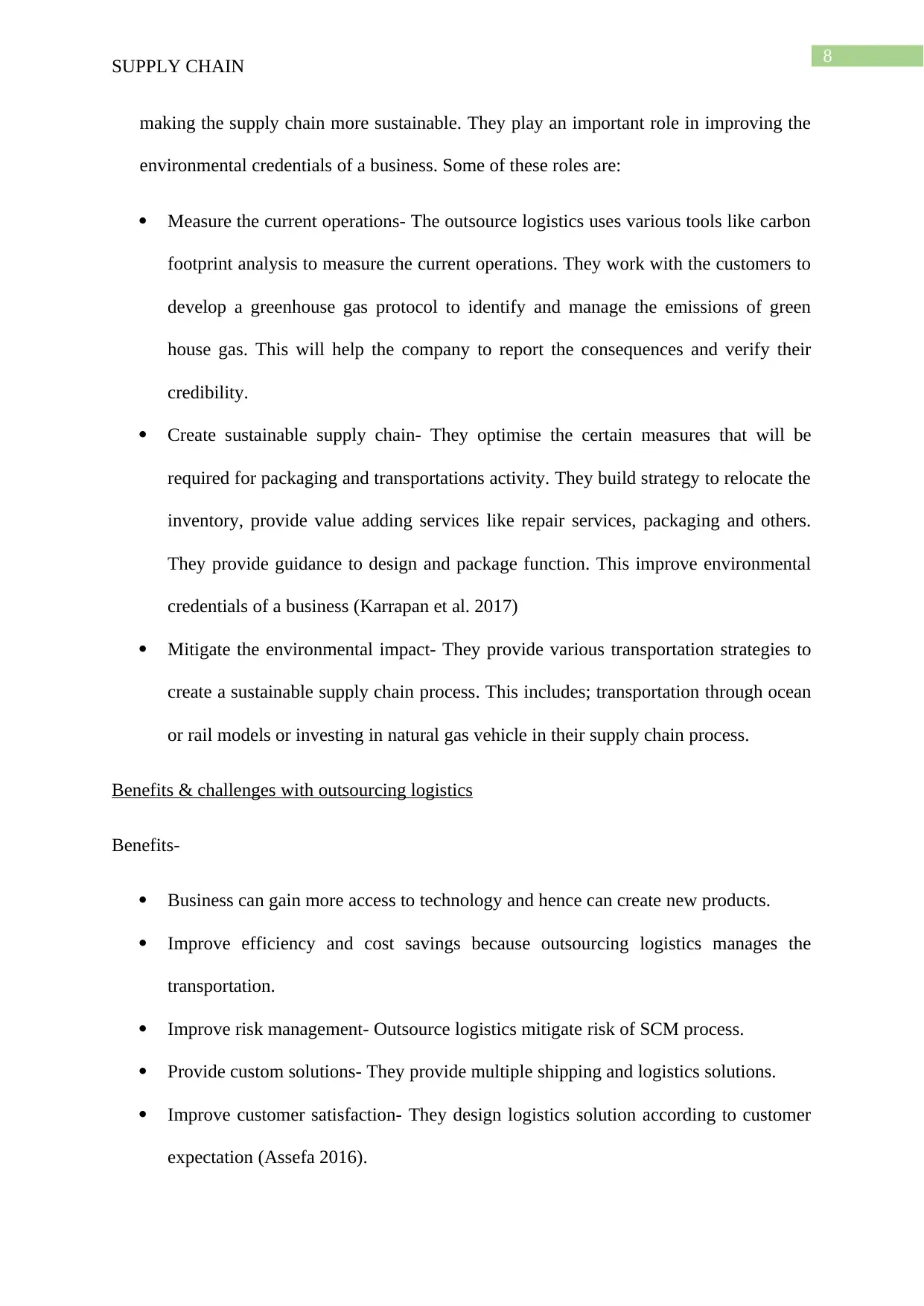
8
SUPPLY CHAIN
making the supply chain more sustainable. They play an important role in improving the
environmental credentials of a business. Some of these roles are:
Measure the current operations- The outsource logistics uses various tools like carbon
footprint analysis to measure the current operations. They work with the customers to
develop a greenhouse gas protocol to identify and manage the emissions of green
house gas. This will help the company to report the consequences and verify their
credibility.
Create sustainable supply chain- They optimise the certain measures that will be
required for packaging and transportations activity. They build strategy to relocate the
inventory, provide value adding services like repair services, packaging and others.
They provide guidance to design and package function. This improve environmental
credentials of a business (Karrapan et al. 2017)
Mitigate the environmental impact- They provide various transportation strategies to
create a sustainable supply chain process. This includes; transportation through ocean
or rail models or investing in natural gas vehicle in their supply chain process.
Benefits & challenges with outsourcing logistics
Benefits-
Business can gain more access to technology and hence can create new products.
Improve efficiency and cost savings because outsourcing logistics manages the
transportation.
Improve risk management- Outsource logistics mitigate risk of SCM process.
Provide custom solutions- They provide multiple shipping and logistics solutions.
Improve customer satisfaction- They design logistics solution according to customer
expectation (Assefa 2016).
SUPPLY CHAIN
making the supply chain more sustainable. They play an important role in improving the
environmental credentials of a business. Some of these roles are:
Measure the current operations- The outsource logistics uses various tools like carbon
footprint analysis to measure the current operations. They work with the customers to
develop a greenhouse gas protocol to identify and manage the emissions of green
house gas. This will help the company to report the consequences and verify their
credibility.
Create sustainable supply chain- They optimise the certain measures that will be
required for packaging and transportations activity. They build strategy to relocate the
inventory, provide value adding services like repair services, packaging and others.
They provide guidance to design and package function. This improve environmental
credentials of a business (Karrapan et al. 2017)
Mitigate the environmental impact- They provide various transportation strategies to
create a sustainable supply chain process. This includes; transportation through ocean
or rail models or investing in natural gas vehicle in their supply chain process.
Benefits & challenges with outsourcing logistics
Benefits-
Business can gain more access to technology and hence can create new products.
Improve efficiency and cost savings because outsourcing logistics manages the
transportation.
Improve risk management- Outsource logistics mitigate risk of SCM process.
Provide custom solutions- They provide multiple shipping and logistics solutions.
Improve customer satisfaction- They design logistics solution according to customer
expectation (Assefa 2016).
⊘ This is a preview!⊘
Do you want full access?
Subscribe today to unlock all pages.

Trusted by 1+ million students worldwide

9
SUPPLY CHAIN
Challenges:
Finding the right outsourcing logistics is quite challenging for the business
It is challenging to meet the third part needs in the logistics activity.
There is no control on third party logistics. This can be sometimes challenging for the
organisation.
Lean Management
Issues of KFC restaurant that is to be addressed
KFC or Kentucky Fried Chicken is one of the world’s quick service restaurants. This
restaurant has gained its competitive position in United States. This is due to growth in
market share of the restaurant in the competitive market. But, the restaurants face pressure
from their competitors, because they will have to maintain their consistency in providing
high-quality service to the customers (Anand and Yeung 2018). The restaurant is facing many
complaints from its customers related to customer service. They slow down the process of
issuing the orders and ordering of foods. The staffs are negatively interacting with the
customers. Issues are also related to food quality. Customers are served with cold foods and
hence, they are dissatisfied with the services that are provided. Other issues related to food
are improper fires, more salt and many more. Other issues is related to health issues. The
fried products are unhealthy for the customers.
Lean operations in addressing the issues
KFC should make changes in their lean operations to provide customer satisfaction.
The changes should be done in the management system to achieve lean operations. The
objective of lean operations is to eliminate the wastes and creating value to the customers.
This strategy should also be implemented by KFC restaurant. The restaurant should introduce
some new products like vegetarian products to attract their customers from the targeted
SUPPLY CHAIN
Challenges:
Finding the right outsourcing logistics is quite challenging for the business
It is challenging to meet the third part needs in the logistics activity.
There is no control on third party logistics. This can be sometimes challenging for the
organisation.
Lean Management
Issues of KFC restaurant that is to be addressed
KFC or Kentucky Fried Chicken is one of the world’s quick service restaurants. This
restaurant has gained its competitive position in United States. This is due to growth in
market share of the restaurant in the competitive market. But, the restaurants face pressure
from their competitors, because they will have to maintain their consistency in providing
high-quality service to the customers (Anand and Yeung 2018). The restaurant is facing many
complaints from its customers related to customer service. They slow down the process of
issuing the orders and ordering of foods. The staffs are negatively interacting with the
customers. Issues are also related to food quality. Customers are served with cold foods and
hence, they are dissatisfied with the services that are provided. Other issues related to food
are improper fires, more salt and many more. Other issues is related to health issues. The
fried products are unhealthy for the customers.
Lean operations in addressing the issues
KFC should make changes in their lean operations to provide customer satisfaction.
The changes should be done in the management system to achieve lean operations. The
objective of lean operations is to eliminate the wastes and creating value to the customers.
This strategy should also be implemented by KFC restaurant. The restaurant should introduce
some new products like vegetarian products to attract their customers from the targeted
Paraphrase This Document
Need a fresh take? Get an instant paraphrase of this document with our AI Paraphraser
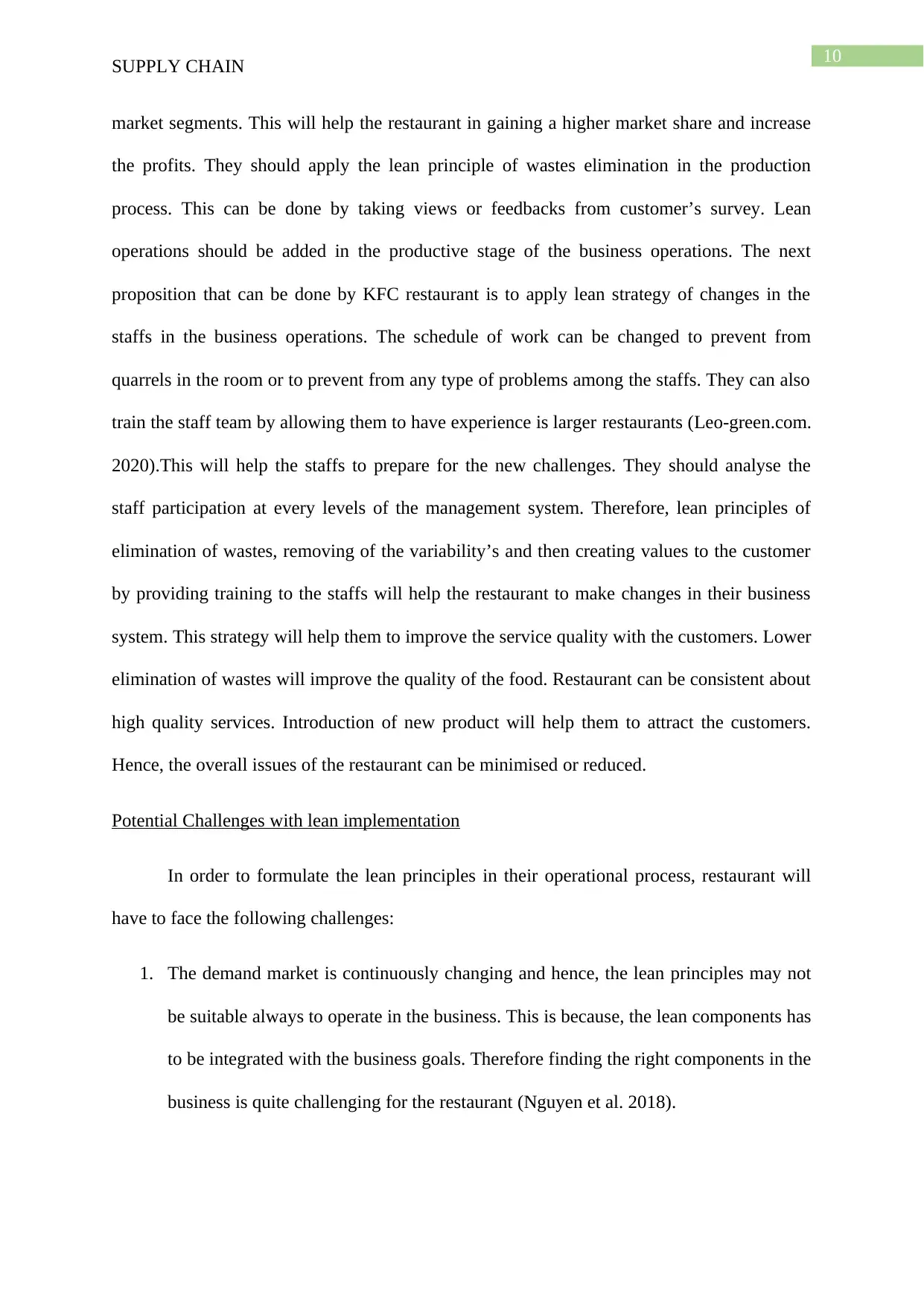
10
SUPPLY CHAIN
market segments. This will help the restaurant in gaining a higher market share and increase
the profits. They should apply the lean principle of wastes elimination in the production
process. This can be done by taking views or feedbacks from customer’s survey. Lean
operations should be added in the productive stage of the business operations. The next
proposition that can be done by KFC restaurant is to apply lean strategy of changes in the
staffs in the business operations. The schedule of work can be changed to prevent from
quarrels in the room or to prevent from any type of problems among the staffs. They can also
train the staff team by allowing them to have experience is larger restaurants (Leo-green.com.
2020).This will help the staffs to prepare for the new challenges. They should analyse the
staff participation at every levels of the management system. Therefore, lean principles of
elimination of wastes, removing of the variability’s and then creating values to the customer
by providing training to the staffs will help the restaurant to make changes in their business
system. This strategy will help them to improve the service quality with the customers. Lower
elimination of wastes will improve the quality of the food. Restaurant can be consistent about
high quality services. Introduction of new product will help them to attract the customers.
Hence, the overall issues of the restaurant can be minimised or reduced.
Potential Challenges with lean implementation
In order to formulate the lean principles in their operational process, restaurant will
have to face the following challenges:
1. The demand market is continuously changing and hence, the lean principles may not
be suitable always to operate in the business. This is because, the lean components has
to be integrated with the business goals. Therefore finding the right components in the
business is quite challenging for the restaurant (Nguyen et al. 2018).
SUPPLY CHAIN
market segments. This will help the restaurant in gaining a higher market share and increase
the profits. They should apply the lean principle of wastes elimination in the production
process. This can be done by taking views or feedbacks from customer’s survey. Lean
operations should be added in the productive stage of the business operations. The next
proposition that can be done by KFC restaurant is to apply lean strategy of changes in the
staffs in the business operations. The schedule of work can be changed to prevent from
quarrels in the room or to prevent from any type of problems among the staffs. They can also
train the staff team by allowing them to have experience is larger restaurants (Leo-green.com.
2020).This will help the staffs to prepare for the new challenges. They should analyse the
staff participation at every levels of the management system. Therefore, lean principles of
elimination of wastes, removing of the variability’s and then creating values to the customer
by providing training to the staffs will help the restaurant to make changes in their business
system. This strategy will help them to improve the service quality with the customers. Lower
elimination of wastes will improve the quality of the food. Restaurant can be consistent about
high quality services. Introduction of new product will help them to attract the customers.
Hence, the overall issues of the restaurant can be minimised or reduced.
Potential Challenges with lean implementation
In order to formulate the lean principles in their operational process, restaurant will
have to face the following challenges:
1. The demand market is continuously changing and hence, the lean principles may not
be suitable always to operate in the business. This is because, the lean components has
to be integrated with the business goals. Therefore finding the right components in the
business is quite challenging for the restaurant (Nguyen et al. 2018).
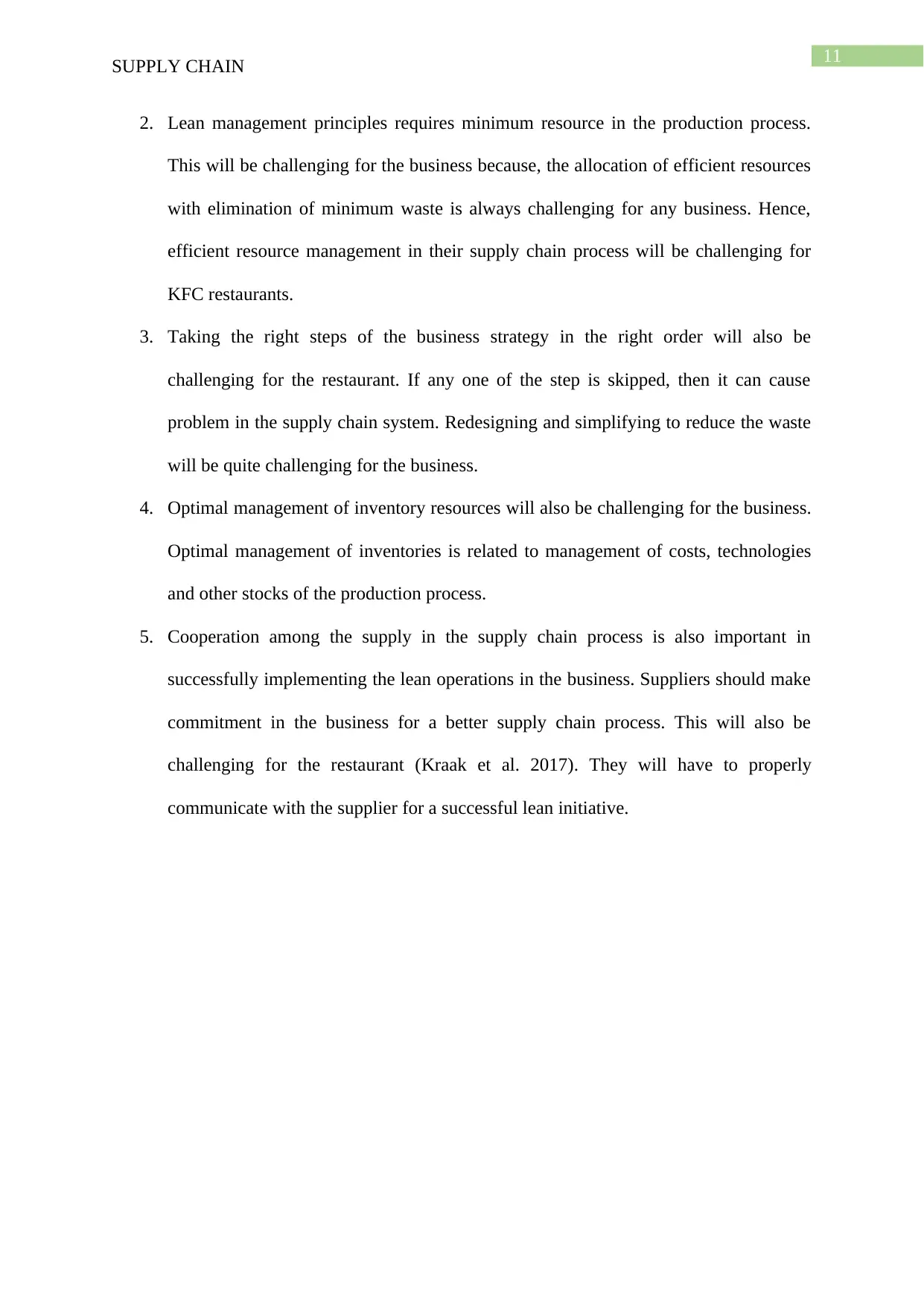
11
SUPPLY CHAIN
2. Lean management principles requires minimum resource in the production process.
This will be challenging for the business because, the allocation of efficient resources
with elimination of minimum waste is always challenging for any business. Hence,
efficient resource management in their supply chain process will be challenging for
KFC restaurants.
3. Taking the right steps of the business strategy in the right order will also be
challenging for the restaurant. If any one of the step is skipped, then it can cause
problem in the supply chain system. Redesigning and simplifying to reduce the waste
will be quite challenging for the business.
4. Optimal management of inventory resources will also be challenging for the business.
Optimal management of inventories is related to management of costs, technologies
and other stocks of the production process.
5. Cooperation among the supply in the supply chain process is also important in
successfully implementing the lean operations in the business. Suppliers should make
commitment in the business for a better supply chain process. This will also be
challenging for the restaurant (Kraak et al. 2017). They will have to properly
communicate with the supplier for a successful lean initiative.
SUPPLY CHAIN
2. Lean management principles requires minimum resource in the production process.
This will be challenging for the business because, the allocation of efficient resources
with elimination of minimum waste is always challenging for any business. Hence,
efficient resource management in their supply chain process will be challenging for
KFC restaurants.
3. Taking the right steps of the business strategy in the right order will also be
challenging for the restaurant. If any one of the step is skipped, then it can cause
problem in the supply chain system. Redesigning and simplifying to reduce the waste
will be quite challenging for the business.
4. Optimal management of inventory resources will also be challenging for the business.
Optimal management of inventories is related to management of costs, technologies
and other stocks of the production process.
5. Cooperation among the supply in the supply chain process is also important in
successfully implementing the lean operations in the business. Suppliers should make
commitment in the business for a better supply chain process. This will also be
challenging for the restaurant (Kraak et al. 2017). They will have to properly
communicate with the supplier for a successful lean initiative.
⊘ This is a preview!⊘
Do you want full access?
Subscribe today to unlock all pages.

Trusted by 1+ million students worldwide
1 out of 14
Related Documents
Your All-in-One AI-Powered Toolkit for Academic Success.
+13062052269
info@desklib.com
Available 24*7 on WhatsApp / Email
![[object Object]](/_next/static/media/star-bottom.7253800d.svg)
Unlock your academic potential
Copyright © 2020–2025 A2Z Services. All Rights Reserved. Developed and managed by ZUCOL.





